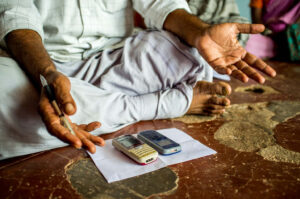GS 2: Governance

Context:
The Comprehensive Modular Survey: Telecom 2025 (CMS), conducted by the NSS, offers deep insights into India’s evolving digital usage, marking a transition from basic access to a more meaningful form of digital participation.
Understanding the Digital Divide
Definition:
The digital divide denotes the disparity in access to digital technologies such as smartphones, internet connectivity, and digital literacy among various demographic groups.
Key Dimensions of the Divide:
- Access Disparity: Differences in mobile ownership and internet penetration.
- Usage Disparity: Varying digital engagement—such as usage for entertainment versus education or productivity.
- Skill Disparity: Limited ability to use ICT tools effectively, like creating documents or reporting cybercrimes.
- Gender Disparity: Lower digital access and usage among women and girls.
Findings from CMS 2025: Trends and Statistics
Access Patterns
- Mobile Usage: 97.1% of youth use mobile phones, with 73.4% owning them.
- Ownership Stats:
- Urban Youth: 82%
- Rural Youth: 69.3%
- Male Youth: 83.3%
- Female Youth: 63%
Usage Patterns
- 91.3% of young women now use the internet (up from 77.1% in 2022).
- 30.4% of youth use the internet mainly for entertainment; this is higher among females (36%).
Skill Proficiency
- 85.1% can send email attachments.
- Only 32.2% have made digital presentations; 22.9% have created documents.
- Online banking usage:
- Overall: 68.7%
- Female: 57.5% vs Male: 79.3%
- Rural: 63.4% vs Urban: 79.7%
Connectivity Disparity
- 91.6% of urban households have internet access compared to 83.3% in rural areas.
- Fibre-optic connection reaches only 7.2% of homes; rural share is just 3.2%.
First-Generation Digital Inclusion Initiatives
- BharatNet Project:
Connected over 1.7 lakh Gram Panchayats with optical fibre, facilitating e-services like health and education in rural regions. - Digital India Programme:
Aimed at comprehensive digital access through Common Service Centres (CSCs), e-lockers, and government services. - PMGDISHA Scheme:
Trained over 6 crore rural citizens in basic digital skills under the Pradhan Mantri Gramin Digital Saksharta Abhiyan. - JAM Trinity & UPI:
Integration of Jan Dhan accounts, Aadhaar, and mobile phones enabled inclusive digital payments through the Unified Payments Interface (UPI).
Outcomes of the First Phase
- Widespread Mobile Usage:
Around 97% of youth, including 92.7% in rural areas, now use mobile phones for communication and internet access. - UPI’s Broad Adoption:
UPI accounts for 80.7% of payment methods among youth, whereas net banking lags behind at just 0.7%. - Mobile-First Access:
Cheap smartphones and data packs made mobile internet the norm, especially in rural areas. Desktop and broadband use remains minimal. - Improved Female Access:
Female internet usage in rural areas surged to 91.3%, showing rising digital participation among women.
Persisting Challenges
- Ownership Gap Among Women:
Only 56.9% of rural young women own a mobile phone versus 81.2% of their male counterparts, limiting personal access. - Lack of Productive Digital Skills:
While consumption is high, only 32.2% of youth created presentations and 22.9% drafted documents, indicating limited digital creation. - Gendered Dependence:
Many women rely on phones owned by male relatives, restricting autonomy and privacy. - Limited Civic Awareness:
Only 26.9% of youth know how to file cybercrime complaints; awareness is lower in rural and female demographics. - Financial Literacy Deficit:
Just 18.8% of youth are familiar with both UPI and net banking, revealing the need for diversified digital financial knowledge.
Second-Generation Reforms: From Access to Empowerment
- Enhance Digital Skills:
Shift focus towards enabling youth to use digital tools for creative and productive purposes like content creation and problem-solving. - Women-Focused Programs:
Equip Self-Help Groups (SHGs) and rural women with digital tools to engage in business, education, and health services. - Strengthen Infrastructure:
Improve fibre-optic connectivity and establish digital hubs in schools and Panchayats. Community Wi-Fi centres can further expand access. - ICT in School Curriculum:
Integrate cyber hygiene, document creation, and digital literacy into school education for early skill development. - Expand Financial Skills:
Provide training in UPI, net banking, and secure digital wallets to rural populations and women. - Localized Awareness Drives:
Use regional languages and culturally relevant content to promote digital usage for education, healthcare, employment, and governance.




